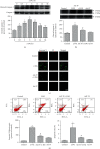Neuroprotection Effect of Astragaloside IV from 2-DG-Induced Endoplasmic Reticulum Stress
- PMID: 33488941
- PMCID: PMC7790552
- DOI: 10.1155/2020/9782062
Neuroprotection Effect of Astragaloside IV from 2-DG-Induced Endoplasmic Reticulum Stress
Abstract
Objective: Astragaloside IV shows neuroprotective activity, but its mechanism remains unclear. To investigate whether astragaloside IV protects from endoplasmic reticulum stress (ERS), we focus on the regulation of glycogen synthase kinase-3β (GSK-3β) and mitochondrial permeability transition pore (mPTP) by astragaloside IV in neuronal cell PC12.
Methods and results: PC12 cells treated with different concentrations of ERS inductor 2-deoxyglucose (2-DG) (25-500 μM) showed a significant increase of glucose-regulated protein 78 (GRP 78) and GRP 94 expressions and a decrease of tetramethylrhodamine ethyl ester (TMRE) fluorescence intensity and mitochondrial membrane potential (∆Ψm), with the peak effect seen at 50 μM, indicating that 2-DG induces ERS and the mPTP opening. Similarly, 50 μM of astragaloside IV increased the GSK-3β phosphorylation at Ser9 most significantly. Next, we examined the neuroprotection of astragaloside IV by dividing the PC12 cells into control group, 2-DG treatment group, astragaloside IV plus 2-DG treatment group, and astragaloside IV only group. PC12 cells treated with 50 μM 2-DG for different time courses (0-36 hr) showed a significant increase of Cleaved-Caspase-3 with the peak at 6 hr. 2-DG significantly induced cell apoptosis and increased the green fluorescence intensity of Annexin V-FITC, and these effects were reversed by astragaloside IV. Such a result indicates that astragaloside IV protected neural cell survival from ERS. 2-DG treatment significantly increased the expressions of inositol-requiring ER-to-nucleus signal kinase 1 (IRE1), phosphor-protein kinase R-like ER kinase (p-PERK), but not affect the transcription factor 6 (ATF6) expression. 2-DG treatment significantly decreased the phosphorylation of GSK-3β and significantly reduced the TMRE fluorescence intensity and ∆Ψm, following mPTP open. Astragaloside IV significantly inhibited the above effects caused by 2-DG, except the upregulation of ATF6 protein. Taken together, astragaloside IV significantly inhibited the ERS caused by 2-DG.
Conclusion: Our data suggested that astragaloside IV protects PC12 cells from ERS by inactivation of GSK-3β and preventing the mPTP opening. The GRP 78, GRP 94, IRE1, and PERK signaling pathways but not ATF6 are responsible for GSK-3β inactivation and neuroprotection by astragaloside IV.
Copyright © 2020 Yu Fu et al.
Conflict of interest statement
The authors declare no conflict of interest associated with this manuscript.
Figures








Similar articles
-
Roles of Endoplasmic Reticulum Stress in NECA-Induced Cardioprotection against Ischemia/Reperfusion Injury.Oxid Med Cell Longev. 2017;2017:2490501. doi: 10.1155/2017/2490501. Epub 2017 Dec 17. Oxid Med Cell Longev. 2017. PMID: 29391923 Free PMC article.
-
Astragaloside IV inhibits oxidative stress-induced mitochondrial permeability transition pore opening by inactivating GSK-3β via nitric oxide in H9c2 cardiac cells.Oxid Med Cell Longev. 2012;2012:935738. doi: 10.1155/2012/935738. Epub 2012 Sep 25. Oxid Med Cell Longev. 2012. PMID: 23050041 Free PMC article.
-
Zn2+ and mPTP mediate resveratrol-induced myocardial protection from endoplasmic reticulum stress.Metallomics. 2020 Feb 26;12(2):290-300. doi: 10.1039/c9mt00264b. Metallomics. 2020. PMID: 31872196
-
[Neurobiological potential of astragaloside IV and prospects for its use in the treatment of Alzheimer's disease].Zh Nevrol Psikhiatr Im S S Korsakova. 2025;125(2):7-12. doi: 10.17116/jnevro20251250217. Zh Nevrol Psikhiatr Im S S Korsakova. 2025. PMID: 40047827 Review. Russian.
-
GSK-3beta, a therapeutic target for cardiomyocyte protection.Circ J. 2009 Jul;73(7):1184-92. doi: 10.1253/circj.cj-09-0284. Epub 2009 Jun 9. Circ J. 2009. PMID: 19506320 Review.
Cited by
-
Exploring the neuroprotective role of melatonin against nickel-induced neurotoxicity in the left hippocampus.Biometals. 2024 Dec;37(6):1457-1469. doi: 10.1007/s10534-024-00618-w. Epub 2024 Jul 26. Biometals. 2024. PMID: 39060834
-
Sarcopenia in pulmonary diseases is associated with elevated sarcoplasmic reticulum stress and myonuclear disorganization.Histochem Cell Biol. 2022 Jan;157(1):93-105. doi: 10.1007/s00418-021-02043-3. Epub 2021 Oct 19. Histochem Cell Biol. 2022. PMID: 34665327
-
The role of hypoxia-inducible factor 1 alpha (HIF-1α) modulation in heavy metal toxicity.Arch Toxicol. 2023 May;97(5):1299-1318. doi: 10.1007/s00204-023-03483-7. Epub 2023 Mar 18. Arch Toxicol. 2023. PMID: 36933023 Review.
-
SERP1 reduces inchoate acute hepatic injury through regulation of endoplasmic reticulum stress via the GSK3β/β‑catenin/TCF/LEF signaling pathway.Mol Med Rep. 2022 Jun;25(6):193. doi: 10.3892/mmr.2022.12709. Epub 2022 Apr 8. Mol Med Rep. 2022. PMID: 35419615 Free PMC article.
-
Roles and Mechanisms of Astragaloside IV in Combating Neuronal Aging.Aging Dis. 2022 Dec 1;13(6):1845-1861. doi: 10.14336/AD.2022.0126. eCollection 2022 Dec 1. Aging Dis. 2022. PMID: 36465185 Free PMC article. Review.
References
MeSH terms
Substances
LinkOut - more resources
Full Text Sources
Medical
Research Materials

